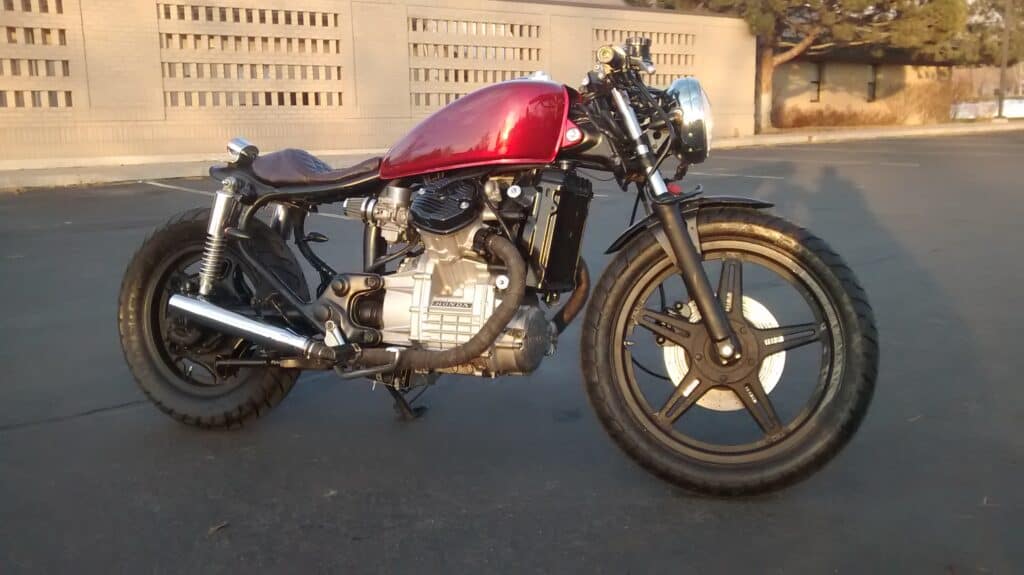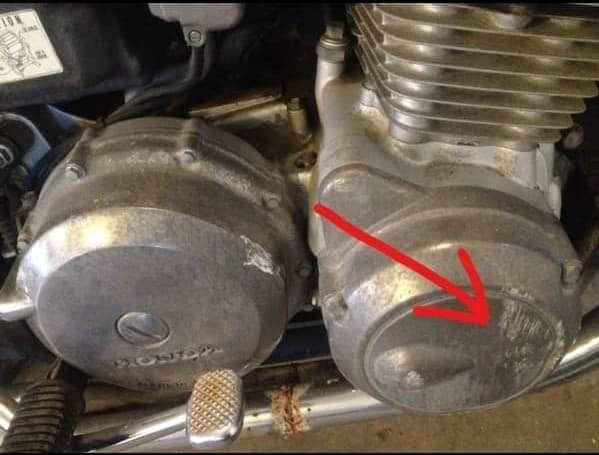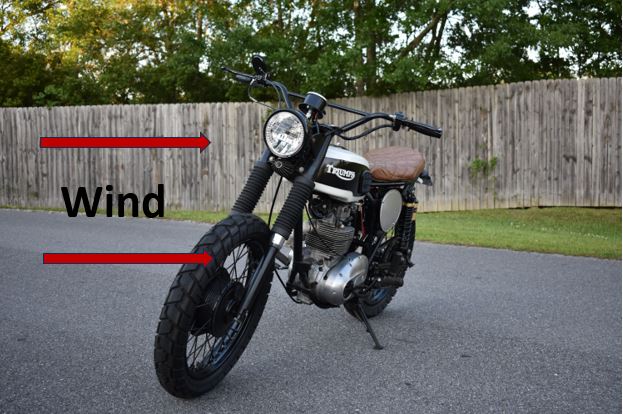
When the elements outside start to become a bit wild, you may be concerned about the impact this can have on your motorcycle.
Wind especially is hard to calibrate. One moment the grass is slowly swaying in the breeze and the next thing you know there are tree branches flying past your window.
Can wind blow over a parked motorcycle? Though it is rare, it is possible for wind to blow over a parked motorcycle. How big the motorcycle is, where it is parked, how it is standing up, and how strong the wind is blowing all contribute to this possibility. The average 400 pound motorcycle can blow over starting at winds that are 50 – 60 miles per hour.
Seeing a motorcycle tipped over on it’s side looks a bit unnatural. It’s one thing to accidentally let it happen while you’re handling it and it’s another when mother nature decides to push it over.
Having lived on the Mississippi coast, I have seen some strong winds and the impact they had on my (and my friends) motorcycles. This guide will discuss how you can prevent such a thing from happening as well as other information you should know about wind and your motorcycle.
When It’s Possible For Wind To Blow Over A Motorcycle
Wind is an interesting phenomenon. It’s an element that we are unable to see but can certainly feel. While it can be a welcomed sensation on a hot, sunny day, it can also bring a lot of devastation if it’s powerful enough.
The amount of damage wind can cause is endless. Some of those damages may include a parked motorcycle. Many motorcyclists believe that it’s not possible for wind to blow over a motorcycle unless you’re in a category 5 hurricane; that’s simply not true. Though the wind does need to be blowing hard, it’s best to know at what point your motorcycle is at risk.
An average motorcycle weighs about 400 pounds. Once wind starts hitting somewhere between 50-60 miles per hour, your motorcycle is at risk of blowing over. This is, of course, a very average situation and the point of when a motorcycle blows over in the wind depends a lot on the size of the motorcycle, what it’s using to keep it up in the first place, and how much the wind is blowing.
According to the National Weather Service, you start getting structural damage to houses around 43 miles per hour. This includes chimney caps coming off, shingles blowing away, and side panels tearing. Once wind reaches to about 55 miles per hour, trees begin to uproot and significant damage to buildings start to happen. Ultimately, once wind starts getting into the low 60 miles per hour range, some widespread damage occurs.
If you notice it’s a windy day outside, take extra precautions and check the weather and see exactly how much the wind is blowing. You should start taking safety and preventative measures if the wind starts anywhere in the 40 miles per hour range in preparation of possible higher winds.
I had several friends that owned motorcycles while I lived in Mississippi. The area I lived in saw many hurricanes which included extremely strong winds. I witnessed watching my friend’s bike tipping over during a tropical storm. I had a few close calls with my own motorcycle, but I was luckily enough to bring them in the garage before the wind got too bad.
The Possible Damages Wind Will Do To Your Motorcycle

The first and main issue you’ll have to worry about is cosmetic related if your motorcycle ends up blowing over. Things such as a scratched tank, scratched crank case, bent handlebars, and bent foot pegs are a probability in a situation like this. Luckily, that’s usually the only damage that’s done if you discover quickly your motorcycle is on it’s side.
If your motorcycle was blown over and you didn’t realize for a few hours, you may run in to some issues with the engine. When a motorcycle is on it’s side for too long, oil can start seeping into the combustion chamber which will cause issues with the fuel and air combustion process.
Since there’s too much material and not enough space for air to get in, your motorcycle may not run. This is a phenomenon called hydrolock. For more information about what happens to a motorcycle when it lays on it’s side, see my article here.
If you are worried about your motorcycle getting blown over without knowing it, you can try using a disc lock alarm. This alarm will siren loudly when it senses movement such as tipping over. You can see the disc lock alarm I recommend here in my list of suggested motorcycle security.
Remember, trees can start uprooting at around 55 miles per hour. You may have shingles, chairs, trampolines, tree branches, and other large objects blowing around that could hit into your motorcycle. This will usually only cause cosmetic damage, but it’s damage you’ll want to prevent.
How To Prevent Wind From Blowing Over Your Motorcycle
While no object is 100% safe in a strong enough wind storm, there are still some preventative measures you can take to lessen the chances of your motorcycle blowing over in the wind.
The first and most obvious way to keep it from blowing over is keeping it inside somewhere. This includes a garage, shed, or even your house. A lot of people don’t have those resources so they need to get a bit creative.
If your motorcycle must be parked outside during a bad wind storm, the first thing you should do is consider which direction the wind is blowing. Put down your motorcycle’s kick stand and have the motorcycle leaning in the same direction the wind is blowing. The wind will push the motorcycle against the kickstand which will give it a better chance at staying up.

Because wind is so unpredictable and can change directions at any given time, you might also want to try tying some sort of brick or cinder block to the kick stand.
I don’t recommend you put the kick stand on top of the cinder block, rather I suggest you put the cinder block on top of the kick stand and tie them together. This may not make a huge difference, but it could give you a few more pounds of force.
If possible, try parking your motorcycle by some sort of wall or building. This will lessen the blow of the wind while acting as a prop to keep the motorcycle up (at least on one side). You may also want to try strapping your motorcycle to the ground. You can do this by using four tow straps and connecting them to the four corners of the motorcycle and fastening them to the ground somehow.
Comprehensive insurance is essential in an situation like this. If you don’t have comprehensive insurance on your motorcycle, you should consider getting it since this is the coverage that will help you get your motorcycle up and running again. You can see our other page here that lists motorcycle insurance agencies near you and compare rates suitable for your needs.
How To Ride A Motorcycle In High Winds
You may be caught in a situation where a high wind storm arose while you were out on your motorcycle either on an errand, while at work, etc. If this is your case, parking your motorcycle isn’t going to be your only problem. Getting home in such conditions isn’t easy.
If possible, leave your motorcycle somewhere safe and have someone come and get you in a car. Riding a motorcycle in winds strong enough to blow your motorcycle over isn’t safe.
If getting a ride isn’t an option, proceed on your motorcycle with caution. Be prepared to be thrown around a little bit from the wind. Ride at a slower but steady speed. You may need to lean according to whichever the direction of the wind is coming from. If possible, ride on less busy roads so you don’t have to worry about getting pushed into as much oncoming traffic.
Be on the lookout for any large objects moving through the air as well as any large objects on the road. Pull over and rest if your body is getting tired; you want to have full control of your body in a situation like this with no depleting strength.
Conclusion
Though it doesn’t happen very often, it is completely possible for the wind to blow over a motorcycle. The possibility of it happening depends a lot on the size of the motorcycle and it’s surroundings. Taking some preventative measures can help with this such as parking it in a garage or shed.
Have you guys ever experienced having a motorcycle parked in a strong wind storm? What were some things you did to help the situation?
